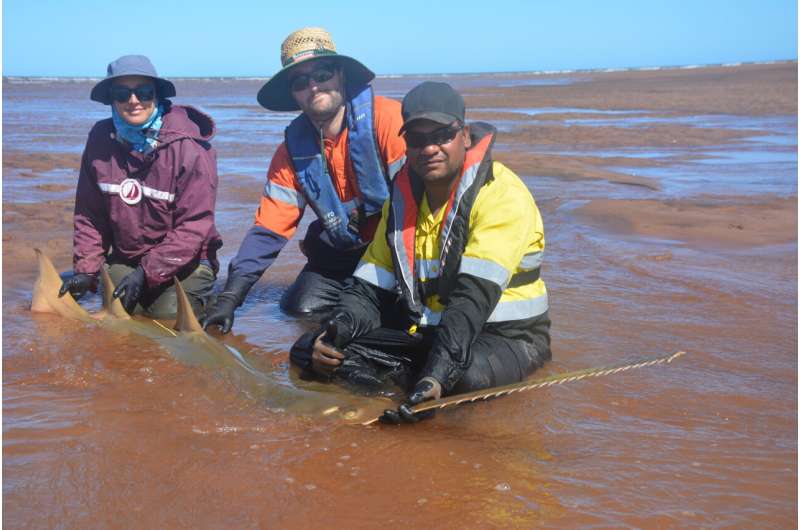This article has been reviewed according to Science X's editorial process and policies. Editors have highlighted the following attributes while ensuring the content's credibility:
fact-checked
trusted source
proofread
Protecting one of the world's most threatened marine animals

Researchers from Murdoch University's Harry Butler Institute have employed the latest genetic techniques to uncover critical breeding and reproductive knowledge about one of the world's most threatened marine animals—the sawfish.
Research fellows Dr. Jack Ingelbrecht and Dr. David Morgan led a team from the Center for Sustainable Aquatic Ecosystems as they reconstructed a series of family trees for green sawfish in WA's Ashburton River.
Dr. Ingelbrecht said one of the biggest barriers in sawfish conservation was how little is known about breeding populations—with this research bridging a critical gap.
Using DNA collected over a 10-year period, researchers discovered that more than 50 female green sawfish had given birth in the Ashburton River estuary or nearby tidal creeks between 2011 and 2022.
They further identified that nine of these female sawfish used the area as a birth site on multiple occasions.
With sawfish believed to be extinct in nearly two dozen countries, and populations continuing to decline, Dr. Ingelbrecht said these research findings would aid conservation work.
"These findings are really important for informing conservation efforts, as they demonstrate that some female green sawfish are actually returning to, and reusing, the same site for pupping," Dr. Ingelbrecht said.
"This suggests that conservation efforts for green sawfish could be more effective if targeted towards protecting key waterways like the Ashburton River."
The green sawfish is one of the largest fishes on the planet, known to grow longer than six meters, and it is critically endangered, making the timing of this project pertinent.
Dr. Ingelbrecht's study, now published in Aquatic Conservation: Marine and Freshwater Ecosystems, identified some 90 half-sibling pairs, including high proportions of both maternal and paternal half-siblings. This provided clarity on what Dr. Ingelbrecht refers to as "sex-biased dispersal."
"This is where individuals of one sex are more prone to returning to their birthplace for reproduction, whereas members of the opposite sex are prone to disperse.
"The presence of so many maternal and paternal half-siblings suggests that dispersal is limited in both female and male green sawfish."
While Dr. Ingelbrecht said it did not prevent the possibility of individuals moving long distances, the findings showed an elevated risk of localized extinction for the species, due to depleted populations of green sawfish being unlikely to be replenished from elsewhere over short time scales.
Dr. Ingelbrecht said he and the research team hoped the research would contribute to more effective species management for green sawfish, as well as leading to similar studies of other sawfish species with similar data deficiencies.
More information: Jack Ingelbrecht et al, Kinship assessment and insights into reproductive behaviour of the Critically Endangered green sawfish Pristis zijsron in Western Australia, Aquatic Conservation: Marine and Freshwater Ecosystems (2024). DOI: 10.1002/aqc.4213
Provided by Murdoch University

















